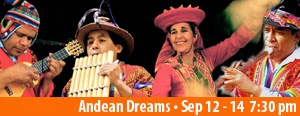 La Luna Nueva is nearly here, and the opening act of this year’s celebration of Latinidad through art and culture is bound to be a unique opportunity for Portland audiences to travel in space and time to Tahuantisuyo, the ancient Incan empire and its continuing history. We were joined by the show’s creators for a brief chat on this amazing new performance.
La Luna Nueva is nearly here, and the opening act of this year’s celebration of Latinidad through art and culture is bound to be a unique opportunity for Portland audiences to travel in space and time to Tahuantisuyo, the ancient Incan empire and its continuing history. We were joined by the show’s creators for a brief chat on this amazing new performance.
We know that Andean Dreams will be filled with Incan music, dance and legends. What motivated you to start this project?
Alex: Some of our most important motivation is providing an opportunity for audiences in this country to learn more about the culture and traditions in the places we come from. This project also helps us as artists in working together and sharing personal creative experiences.
Unos de los motivos más importante para nosotros es el brindar la oportunidad para que audiencias de este país conozcan mas sobre la cultura y las tradiciones de donde somos nosotros. También este proyecto nos ayuda como artistas a trabajar juntos y a compartir experiencias personales y artísticas.
Luciana: Alex called me to join him on this project and for me, that is a chance to work closely with a great musician of ample mind, and with whom I share roots.
What can our audiences expect in Andean Dreams?
Alex: The public coming to this event will expand their knowledge of Andean culture, and be able to partake in a unique experience.
Luciana: Andean culture, as well as other ancestral cultures sharing this world, has preserved a very close relationship to archetypes, which lends it a universal appeal. It is a show of emotions rather than explanations. From mystery to joy.
The wind instruments are characteristic of Andean music, and create interesting sounds and forms. What are some of the instruments we will enjoy during Andean Dreams?
Alex: We will be performing on instruments known as zampoñas and quenas (flutes constructed from wood and bamboo.) Other traditional instruments that will be heard are tarkas, “the feathered flutes”, ceramic instruments that replicate the singing of birds.
Luciana: We also use the erke, a giant horn, and the conch shell. The first part will only use wind (instruments), voice and percussion, and the second part will integrate string instruments: guitar, charango, mandolin and violin.
In terms of dance, what regions of the ancient Incan Empire will spectators see come alive on stage during La Luna Nueva? Are some of these dances still representative of the region?
Alex: Of course, these dances are representations of traditional rhythms from the Andean regions of Bolivia, Ecuador and Peru.
Luciana: No one knows with certainty what pre-Columbian dance was like, especially pre-Incan times, except through the vague references of some chroniclers. What we do know is what the instruments and costuming were like. In the first part, the dances are based on indigenous rhythms that must have their roots in said cultures, but our interpretations are very free. We also know that the use of music and dance was constant and with various purposes. In any case we assumed that the music as well as the dance were a vehicle for the meeting of the here and now with eternity. In the second part of the show we will utilize contemporary indigenous costuming with a marked Spanish colonial influence, corresponding to the introduction of European, stringed instrumentation.
Why is it, in your opinion, that no one should miss the performances during La Luna Nueva?
Alex: Andean Dreams is only the beginning of a path that goes much farther than this event. The public at this event will be part of an important chapter in Andean culture for the region, and that is an opportunity not to be missed.
Luciana: No one should miss out on the chance to participate in a spectacle of live music and dance that will make them dance out of their seats. This rhythm is highly contagious. No one should miss the opportunity to make magic together, of experiencing joy together. We’ll be waiting for you! ¡Alegría!
Una charla sobre «Andean Dreams»
Ya casi está aquí La Luna Nueva, la celebración en arte y cultura de la herencia hispana, y nuestro evento inaugural será algo muy único para Portland: una oportunidad a transportarnos en el tiempo y el espacio a Tahuantisuyo, el antiguo Imperio Inca y su milenaria historia. Recientemente nos sentamos en una corta charla con los creadores del espectáculo para aprender más sobre que nos espera en tan mágica noche.
Sabemos que en Andean Dream música, bailes y leyendas incas estarán presentes ¿Qué los motivó a iniciar este proyecto?
Alex: Unos de los motivos mas importante para nosotros es el brindar la oportunidad para que audiencias de este país conozcan mas sobre la cultura y las tradiciones de donde somos nosotros. También este proyecto nos ayuda como artistas a trabajar juntos y a compartir experiencias personales y artísticas.
Luciana: Alex me llamó para acompañarlo en este trabajo y para mí es una oportunidad trabajar de cerca con un gran músico de mente amplia y con quien comparto parte de mis raíces.
¿Qué pueden esperar nuestras audiencias en Andean Dreams?
Alex: Lo que el publico que asista a este evento puede expandir más su conocimiento de la cultura andina, y también ser parte de esta experiencia única.
Luciana: La cultura andina, así como otras culturas ancestrales que conviven en el mundo, ha conservado bastante de cerca su relación con el arquetipo, por lo tanto tendrá una validez universal. Se trata de un espectáculo de sensaciones más que de explicaciones. Del misterio a la alegría.
Los instrumentos de viento son característicos de la música andina, y siempre presentan interesantes sonidos y formas ¿cuál(es) son algunos de los que disfrutaremos durante Andean Dreams?
Alex: Interpretaremos instrumentos conocidos como las zampoñas, y quenas.(flautas fabricadas en bambú y madera)
Otros instrumentos tradicionales a escuchar son las tarkas, flauta de plumas, instrumentos de ceramica que recrean el cantar de la aves.
Luciana: También utilizamos el Erke, un corno gigante, y el caracol. La primera parte utilizará sólo vientos, voces y percusión y en la segunda parte incluiremos instrumentos de cuerda: la guitarra, el charango, la mandolina, el violín.
En cuanto al baile, ¿de cuáles regiones del antiguo imperio Inca tendrán los espectadores la oportunidad de disfrutar en vivo en el escenario de La Luna Nueva, ¿son algunos de estos bailes aun representativos en dichas regiones?
Alex: Por supuesto estos bailes son representaciones de ritmos tradicionales de las regiones andinas de Bolivia, Ecuador y Peru.
Luciana: Nadie sabe con certeza cómo fueron los bailes precolombinos, sobre todo los pre-incas, salvo por referencias vagas de algunos cronistas. Lo que sí sabemos es cómo eran los instrumentos y los trajes. En la primera parte los bailes se basan en ritmos autóctonos que deben haber tenido sus raíces en dichas culturas, pero nuestra interpretación es bastante libre. También sabemos que el uso de la música y la danza fue constante y de intenciones variadas. En todo caso asumimos que tanto la música como la danza fueron un vehículo para el encuentro del aquí y ahora con la eternidad. En la segunda parte del espectáculo utilizaremos vestuario indígena contemporáneo que tiene una marcada influencia colonial española correspondiendo así a la introducción de la instrumentación europea con cuerdas.
¿Por qué, en su opinion, nadie se puede perder las presentaciones que se realizarán durante La Luna Nueva?
Alex: Andean Dreams es el comienzo de un camino que seguirá mucho más allá de este evento. La gente que asista a este evento será parte de un capítulo muy importante de la cultura andina en esta región, y esa es una oportunidad para no perdérsela. Esperamos su opinión y su participación como comunidad.
Luciana: Nadie debe perder la oportunidad de participar en un espectáculo de música y danza en vivo que los va a hacer bailar saliéndose de sus asientos. Esta música es sumamente contagiosa. No hay que perderse la oportunidad de hacer magia juntos, de estar felices juntos. Los esperamos siempre. ¡¡¡Alegría!!!


